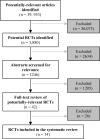Estimating the Horizon of articles to decide when to stop searching in systematic reviews: an example using a systematic review of RCTs evaluating osteoporosis clinical decision support tools
- PMID: 18693864
- PMCID: PMC2655834
Estimating the Horizon of articles to decide when to stop searching in systematic reviews: an example using a systematic review of RCTs evaluating osteoporosis clinical decision support tools
Abstract
Researchers conducting systematic reviews need to search multiple bibliographic databases such as MEDLINE and EMBASE. However, researchers have no rational search stopping rule when looking for potentially-relevant articles. We empirically tested a stopping rule based on the concept of capture-mark-recapture (CMR), which was first pioneered in ecology. The principles of CMR can be adapted to systematic reviews and meta-analyses to estimate the Horizon of articles in the literature with its confidence interval. We retrospectively tested this Horizon Estimation using a systematic review of randomized controlled trials (RCTs) that evaluated clinical decision support tools for osteoporosis disease management. The Horizon Estimation was calculated based on 4 bibliographic databases that were included as the main data sources for the review in the following order: MEDLINE, EMBASE, CINAHL, and EBM Reviews. The systematic review captured 68% of known articles from the 4 data sources, which represented 592 articles that were estimated as missing from the Horizon.
Figures
References
-
- Moher D, Cook DJ, Eastwood S, Olkin I, Rennie D, Stroup F, for the QUOROM Group Improving the quality of reports of meta-analyses of randomized controlled trials: the QUOROM statement. Lancet. 1999;354:1896–1900. - PubMed
-
- Chapman DG. The Estimation of Biological Populations. Ann Math Stat. 1954;25:1–15.
-
- Pollock KH. Modeling Capture, Recapture, and Removal Statistics for Estimation of Demographic Parameters for Fish and Wildlife Populations: Past, Present, and Future. J Am Stat Assoc. 1991;86(413):225–38.
-
- Hook EB, Regal RR. Capture-recapture methods in epidemiology: methods and limitations. Epidemiol Rev. 1995;17:243–64. - PubMed
-
- Bennett DA, Latham NK, Stretton C, Anderson CS. Capture-recapture is a potentially useful method for assessing publication bias. J Clin Epi. 2004;57:349–57. - PubMed
MeSH terms
LinkOut - more resources
Full Text Sources


